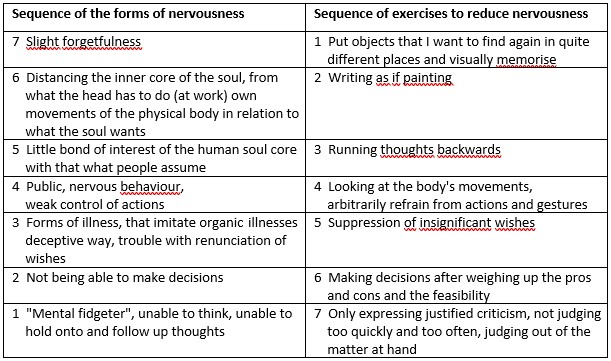Group courses on nervousness: anthroposophic/activity based stress reduction (ABSR)
Harald Haas
Last update: 04.05.2022
In 1912, Rudolf Steiner, founder of anthroposophy, gave a lecture with the title "Nervous conditions in our times" (1). In this, various symptoms of nervousness in anxiety and neurosis are addressed, such as "haste of the soul life, inability to make decisions, imitation of organic illnesses" are addressed. This is followed by instructions for exercises, which may be categorized in seven aspects:
- „conscious misplacing of objects“,
- „consciously changing writing habits“,
- „thinking backwards“,
- „observing one's own gestures; consciously 'changing' some things, e.g. use of left hand“,
- „renunciation, suppression of small wishes“,
- „consideration of the pros and cons of a matter“,
- „restraint in judgement, especially where one is affected oneself“.
The correlations of the lecture topics listed below show that, on the one hand, the seven forms or types of nervousness described at the beginning of the lecture – in sections two to nine of the lecture text – are related in mirrored order to the seven exercises of the second part of the lecture – from section nine to the penultimate section of the lecture.

The whole presentation is framed by the first and the last section, which also have an inner, expanding connection with each other. This is the "application of spiritual science to life" and that "self-education and influence on education" are things "which can arise from our basic anthroposophical conviction" (1). This idea is also taken up again and again in various intervening sections – especially in sections 10, 15, 17 and 21 of the lecture text.
Rudolf Steiner's remarks on nervousness show a great deal of correspondence with the disorder now known as Attention Deficit Disorder and its many comorbid conditions such as anxiety, neurotic and affective disorders, about which I previously published in 2006 (2).
Elements of the ABSR course
In my psychotherapeutic work, it became apparent that patients are often unaccustomed to and initially find it difficult to do exercises on their own. Once they have decided to do so,
they often need support by asking questions or practicing together. For this reason, the possibility of conducting an exercise group, designed according to the formal procedure of the Mindfulness-Based Stress Reduction (MBSR)- or the Mindfulness Based Cognitive Therapy (MBCT)-groups of Jon Kabat-Zinn proved to be very helpful, especially when supplemented with suitable eurythmy exercises, to support the sustained engagement of the patients. For an "anthroposophical mindfulness course" or activity based stress reduction (ABSR), eurythmy or eurythmy therapy elements could be used instead of the 'body meditations' and yoga exercises in the MBCT or MBSR course.
The course program, which has been carried out regularly in groups of six to 10 people in my practice since 2012, has since then proven itself in its implementation.
The overview of the course program (link below) shows that further topics (first column) have been added. These are, on the one hand, the so-called four members of the human being and the elements, the soul and the temperaments, the I and the spirit, which Rudolf Steiner mentions in the lecture (1), since these themes are not considered to be familiar. On the other hand, it is the soul moods of compassion, conscience and wonder that can be derived as salutogenetic elements. The assignment of the (therapeutic) eurythmy exercises was newly developed and became more concrete in the course of the group events. The fourth column shows the mental abnormalities with which the respective exercises can be related. This also makes it possible to make a symptom-oriented selection for an individual application.
Here you get the tabular overview of the program.
Evaluation of the ABSR course
In addition to the concrete participant experience and feedback thus far, an initial psychological test evaluation was completed as a dissertation with the support of Dr. med. Ursula Wolf, Professor of Anthroposophical Medicine and Co-Director of the Institute for Complementary Medicine in Bern (Switzerland). The results are to be published shortly. It was observed to what extent Coping Questionnaires and assessment of well-being by means of the MBDF can reflect the changes brought about by the exercise process. As a physiological parameter for a pre- and post-assessment of the vegetative state, the heart rate variability was collected with the participants' consent. From individual results it is evident that psychological changes in the test only occurred if the participants regularly practised at home.
In 2019, the individual group course and in 2020 the guided group course were scientifically evaluated by the University of Bern in a medical master's thesis and an accompanying study. The results of these are also to be published shortly. Further studies are in progress and are to be carried out by the research group www.perseus-forschung.org.
Using the ABSR course
It is possible that instead of eurythmy exercises, other arts could also be integrated into the exercise sequence. This has been tested in training groups with therapeutic speech formation and music therapy. If interested, the course program can also be sent as a Word file on mail request (harald.haasbe@bluewin.ch) to facilitate independent processing.
The dossier of the entire course program in German with the texts of the lecture "Nervous conditions in our times" (1) is freely available at the web address www.achtsamwerden.ch.
At www.eurythmy4you.com the program is offered in several languages as an eight-week online course for individual work. This program has been offered as a guided group course since 2020, and has repeatedly been conducted online with several hundred participants in German, English, Spanish and Russian.
See also the article “Stress and the Activity Based Stress Reduction Program (ABSR) - Background and Phenomena of the Stress Response”: https://www.anthromedics.org/PRA-1001-DE.
Bibliography
- Steiner R. Nervosität und Ichheit. Stressbewältigung von innen. 5. Aufl. Basel: Rudolf Steiner Verlag; 2020.
- Haas H. Das Verständnis der Aufmerksamkeits-Defizit-Störung auf Grundlage des Nervositätsbegriffs bei Rudolf Steiner. Der Merkurstab 2006;59(2):131-142. DOI: https://doi.org/10.14271/DMS-18856-DE.